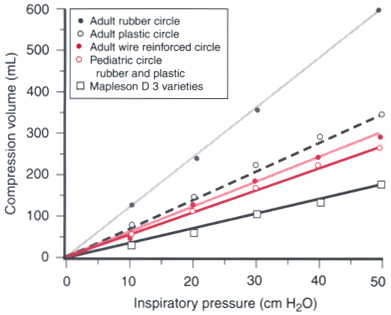 |
 |
Figure 60-15
Eight types of anesthesia circuits were compared regarding
ventilatory losses (circuit efficiency) as a result of compression of anesthetic
gases (compression volume) and stretching of the circuit (compliance volume). Compression
volume and compliance volume losses vary by as much as a factor of 5, depending on
the volume of the circuit and the material from which it is constructed. Low-volume,
low-compliance circuits (Mapleson D systems) are the most efficient and give the
anesthesiologist the greatest amount of tactile feedback regarding tidal volume and
lung compliance in small patients. Although large-volume, high-compliance circuits
(adult circle systems) can be used in small patients, it is very difficult to estimate
tidal volume and lung compliance because circuit-related losses in compression and
compliance volumes are so large. (Redrawn from Coté CJ, Petkau AJ,
Ryan JF, et al: Wasted ventilation measured in vitro with eight anesthetic circuits
with and without inline humidification. Anesthesiology 59:442–446, 1983.)

 |
